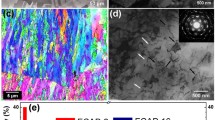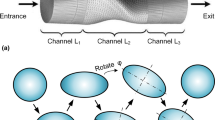Abstract
Axisymmetric reverse extrusion experiments were conducted on annealed Cu rod specimens to form cup-shaped structures with sidewall thicknesses ranging from ∼400 µm down to ∼25 µm. Changes in Cu grain morphology, size, and texture were examined through scanning electron microscopy and electron backscatter diffraction (EBSD). Pole figure and orientation distribution function analysis of EBSD data showed the same texture components in the present small-scale metal forming experiments as those observed in macroscale sheet metal rolling. The plastic deformation became inhomogeneous as the characteristic dimension for extrusion decreased to ∼25 µm, such that the deformation process involved a small number of Cu grains. Extrusion force–punch displacement curves were measured as a function of extruded cup sidewall thickness and compared to outputs of a continuum plasticity finite element analysis in corresponding geometries. The present work illustrates materials characteristics in small-scale metal forming and suggests directions of future work for bringing improved correspondence between experimentation and modeling.








Similar content being viewed by others
References
L. Alting, F. Kimura, H.N. Hansen, and G. Bissacco: Micro engineering. CIRP Ann. — Manuf. Technol. 52, 635–657 (2003).
T. Masuzawa: State of the art of micromachining. CIRP Ann. — Manuf. Technol. 49, 473–488 (2000).
K.H. Ho and S.T. Newman: State of the art electrical discharge machining (EDM). Int. J. Mach. Tool Manufact. 43, 1287–1300 (2003).
J. Meijer: Laser beam machining (LBM), state of the art and new opportunities. J. Mater. Process. Technol. 149, 2–17 (2004).
M. Geiger, M. Kleiner, R. Eckstein, N. Tiesler, and U. Engel: Microforming. CIRP Ann. — Manuf. Technol. 50, 445–462 (2001).
S.R. Agnew, P. Mehrotra, T.M. Lillo, G.M. Stoica, and P.K. Liaw: Texture evolution of five wrought magnesium alloys during route A equal channel angular extrusion: Experiments and simulations. Acta Mater. 53, 3135–3146 (2005).
Y.J. Chen, Q.D. Wang, H.J. Roven, M. Karlsen, Y.D. Yu, M.P. Liu, and J. Hjelen: Microstructure evolution in magnesium alloy AZ31 during cyclic extrusion compression. J. Alloys Compd. 462, 192–200 (2008).
J.D. Robson, A.M. Twier, G.W. Lorimer, and P. Rogers: Effect of extrusion conditions on microstructure, texture, and yield asymmetry in Mg–6Y–7Gd–0.5 wt% Zr alloy. Mater. Sci. Eng., A 528, 7247–7256 (2011).
N. Pardis, C. Chen, R. Ebrahimi, L.S. Toth, C.F. Gu, B. Beausir, and L. Kommel: Microstructure, texture and mechanical properties of cyclic expansion-extrusion deformed pure copper. Mater. Sci. Eng., A 628, 423–432 (2015).
U. Engel and R. Eckstein: Microforming—From basic research to its realization. J. Mater. Process. Technol. 125/126, 35–44 (2002).
W.L. Chan, M.W. Fu, and J. Lu: Experimental and simulation study of deformation behavior in micro-compound extrusion process. Mater. Des. 32, 525–534 (2011).
W.D. Callister: Materials Science and Engineering, an Introduction, 7th ed. (Wiley, New York, 2007); ch. 6.
ABAQUS: User’s Manual (Version 6.12) (Dassault Systemes Simulia Corp., Providence, RI, USA, 2012).
M.P. Groover: Fundamentals of Modern Manufacturing, Materials, Processes, and Systems, 4th ed. (Wiley, Hoboken, New Jersey, 2010).
U.F. Kocks, C.N. Tome, and H.R. Wenk: Texture and Anisotropy, Preferred Orientations in Polycrystals and Their Effect on Materials Properties (Cambridge University Press, Cambridge, England, 2000).
H. Lyu, N. Taheri-Nassaj, and H.M. Zbib: A multiscale gradient-dependent plasticity model for size effects. Philos. Mag. 96, 1883–1908 (2016).
J. Jiang, G.B. Sinclair, and W.J. Meng: Quasi-static normal indentation of an elasto–plastic substrate by a periodic array of elastic strip punches. Int. J. Solid Struct. 46, 3677–3693 (2009).
P. Hu, Y.Q. Liu, and J.C. Wang: Numerical study of the flange earring of deep-drawing sheets with stronger anisotropy. Int. J. Mech. Sci. 43, 279–296 (2001).
J.W. Yoon, R.E. Dick, and F. Barlat: A new analytical theory for earring generated from anisotropic plasticity. Int. J. Plast. 27, 1165–1184 (2011).
N. Krishnan, J. Cao, and K. Dohda: Study of the size effect on friction conditions in micro-extrusion: Part 1—Micro-extrusion experiments and analysis. ASME J. Manuf. Sci. Eng. 129, 669–676 (2007).
A.G. Evans and J.W. Hutchinson: A critical assessment of theories of strain gradient plasticity. Acta Mater. 57, 1675–1688 (2009).
R.K. Abu Al-Rub and G.Z. Voyiadjis: Analytical and experimental determination of the material intrinsic length scale of strain gradient plasticity theory from micro- and nano-indentation experiments. Int. J. Plast. 20, 1139–1182 (2004).
ACKNOWLEDGMENTS
The authors gratefully acknowledge partial project support from the U.S. National Science Foundation (NSF OIA-1541079) and the Louisiana State Board of Regents (LEQSF(2013-16)-RD-B-01). The experimental work used facilities at the LSU shared instrumentation facility (SIF), a part of the NSF EPSCoR CIMM core user facilities (CUFs). WJM acknowledges discussions with Profs. J.W. Hutchinson and Shuai Shao with thanks.
Author information
Authors and Affiliations
Corresponding author
Supplementary Material
Rights and permissions
About this article
Cite this article
Zhang, B., Song, Y., Voyiadjis, G.Z. et al. Assessing texture development and mechanical response in microscale reverse extrusion of copper. Journal of Materials Research 33, 978–988 (2018). https://doi.org/10.1557/jmr.2018.22
Received:
Accepted:
Published:
Issue Date:
DOI: https://doi.org/10.1557/jmr.2018.22




